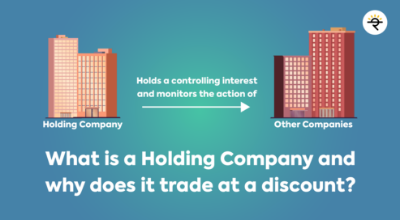Where a company is holding a large chunk of investments in other companies and it's not having any material Business operations of its own, is called a "Holding Company" A holding company typically does not have its own business operations other than the retention and management of assets in anticipation of future sale or trade or may be as a tool of corporate restructuring. The Holding Company thus derives its income primarily through the return on the assets held for investment purpose. In most cases, income of a Holding Company is only the Dividends received by it's from the investments made in other companies.
Most companies are valued by discounting their future earnings. However, if we look at the income source of the holding companies, it is typically, dividend income declared by their portfolio companies.
There are two ways to look at value of a holding company-
- Value based on Income: As the Income of a holding Company may be negligible when compared to the Value of its underlining Assets i,e. investments, it doesn’t make sense to value it based on Income
- Value based on Assets: The real asset of the holding company is their stake in the portfolio companies and therefore the better way to value these companies will be through the investment value route. Thus, the value of a holding company needs to be based on the assets it holds i.e. based on the value of its subsidiary companies.
Now, you must be thinking…it will be pretty simple to value such companies, we just have to take the aggregate value of the portfolio companies, but.. there is something called the holding discount which has to be factored in.
Why is such a discount even considered?
- Liquidation discount
As such the value of Holding Company is based on the sum values of its subsidiaries. However, liquidation discount is generally provided for built in or embedded capital gains even when no liquidation is planned, more so as far as the value if assets of the subsidiary to pass to the Holding Company, it must pay taxes. Holding period, rate of tax may determine this discount.
- Discount for lack of control:
The Holding company value also gets discounted on account of lack of control, for example a Holding company holds 100% stake in a subsidiary & a Holding company holds 15% stake in a company both have different value preposition i.e. the one in which 100% stake is held have a controlling value and the one in which 15% is held shall not command that much proportionate value. Often discount for lack of control on subsidiaries is applied. The less % of holding, the more the discount & vice versa.

- Discount for Lack of Marketability:
Due to separate legal entity often more restrictions exists upon transfer of assets of subsidiary company by Holding Company which leads to discount for Lack of Marketability in the hands of the Holding company.
It's been generally observed that a discount in the range of 40 to 60% on the NAV of the portfolio of the holding companies is applied. But adjustments should be made to the discount depending on the dividends paid and received by the holding company and also expected future scenario of the company. The type of investments the holding company holds also has an impact on the discount that should be applicable for holding company in question. It may also be stated that reorganization of Holding Company may also result in Value Creation.
Some of the Indian listed Holding companies are Bajaj Holdings & Investment Limited, Tata Investment Corporation Limited, Kama Holdings Ltd etc.
Now, coming after understanding what is a holding company and why does it trade at discount, we move to the recent rally of Tata Chemicals, where the sudden and sharp rally can be attributed to its 2.5% stake in Tata Sons. Reports suggest that Tata Sons could achieve a market valuation of ₹ 11 lakh crore, valuing Tata Chemicals' 2.5% holding at approximately ₹19,850 crore, which is close to 60% of its current market capitalization of ₹33,520 crore.
To understand more about such interesting concepts along with further interesting examples, check out my course on Fundamental Analysis.
Until next time !!!


